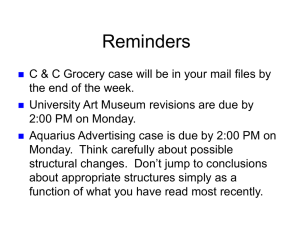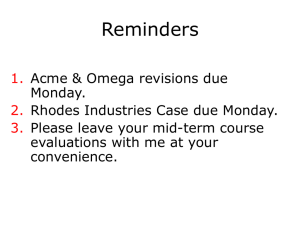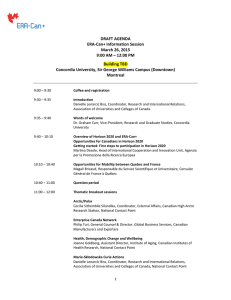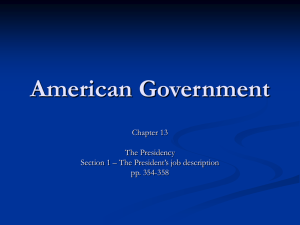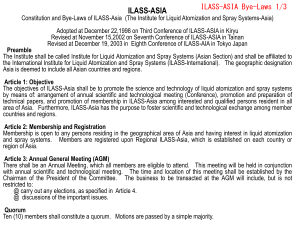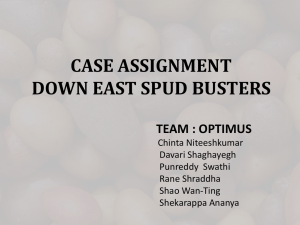Fundamentals of Organization Structure
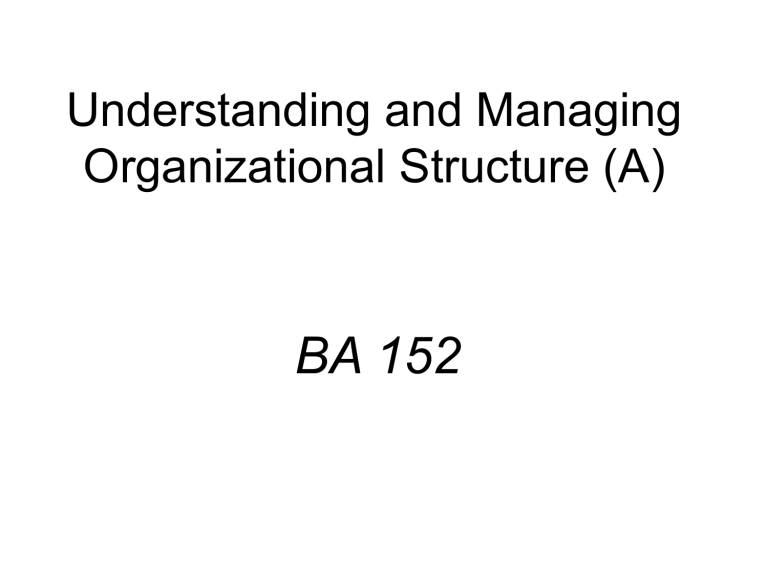
Understanding and Managing
Organizational Structure (A)
BA 152
Today’s Questions
1.
2.
3.
4.
What do we mean by the term,
“structure?”
What influences the structural choices made by managers?
What are two of the most popular organizational structures?
What are the relative advantages and disadvantages of these structures?
Characteristics of Organizations
Environment Goals
Strategies
Structures
Technologies
Systems
People
Cultures
What is Structure?
The allocation of responsibilities
Formal reporting channels
The systems that coordinate effort
The way the company is put together.
Becoming an Organization
Complexity
Vertical
Horizontal
Vertical/Horizontal Division of Labor
Making Things
President
Vice-Presidents
Middle Managers
Supervisors
First-Line Employees
Vertical
Complexity
Selling Things Getting Money Designing Things Dealing with People
Horizontal Complexity
Becoming an Organization
Complexity
Vertical
Horizontal
Centralization
Formalization
Influences on Structure
Environment
Industry FIT!
Strategic Choice/Goals
Organizational Size
Technology
Structuring Work
A Craft Approach
DMS Corp.
D
=M
S
D
=M
S
D
=M
S
D = Design, M = Make, and S = Sell
Structuring Work
A Craft Approach
Advantages
Close supervision
Experts doing all of the tasks
Quality should be higher
Disadvantages
Difficult to find experts
Unable to meet increased demands
D
=M
S
Equipment sits idle, and we lose possible economies of scale
Structuring Work
A Functional Approach
=D =M
DMS Corp.
Functions
=S
A Functional Organization
President
Vice-President
Manufacturing
Vice-President
Engineering
Vice-President
Finance &
Accounting
Vice-President
Marketing
Director
Quality Control
Director
Inventory Control
Director
Product Scheduling
By engineering specialties By F&A specialties By marketing specialties
1.
2.
Characteristics of Functional
Structures
Those doing the “same thing” are in the same function.
More standardized methods and procedures within each function
3.
4.
5.
Characteristics of Functional
Structures
Higher degree of control/centralization within each function and at the top of the organization.
The functions are organized as cost centers.
This structure is competitive in stable environments demanding efficiency.
Kenan-Flagler Business School
Functional Structure
DEAN
Accounting
Dept.
Chairman
Full
Profs.
Assoc.
Profs.
Assist.
Profs.
Marketing
Dept.
Chairman
Full
Profs.
Assoc.
Profs.
Assist.
Profs.
Management
Dept.
Chairman
Full
Profs.
Assoc.
Profs.
Assist.
Profs.
Finance
Dept.
Chairman
Full
Profs.
Assoc.
Profs.
Assist.
Profs.
Operations
Dept.
Chairman
Full
Profs.
Assoc.
Profs.
Assist.
Profs.
President Functional Structure
Vice-President
Manufacturing
Vice-President
Engineering
Vice-President
Finance &
Accounting
Advantages
– Economies of scale
– Supervision/training by specialists
– Promotion within specialty
Vice-President
Marketing
President
Functional Structure
Vice-President
Manufacturing
Vice-President
Engineering
Vice-President
Finance &
Accounting
Vice-President
Marketing
Disadvantages
– Short-term time perspective within functions
– Conflicts across functions
– Coordination problems between functions
– Goal displacement
– Less innovation
– Less flexibility
Ways to Coordinate Activities across Functions
Task forces (temporary)
Task Teams (permanent)
Functional Structure with task forces/teams
President
Engineering Marketing Manufacturing R&D
Task
Force
Functional Structure with task forces/teams
President
Engineering Marketing Manufacturing R&D
Task
Team
Functional Structure with task teams
President
Task
Team
Task
Team
Task
Team
Task
Team
Task
Team
DMS Corp.
Division
Structuring Work
A Divisional Approach
=D =M
East Region
=S
=D =M
Central Region
=S
=D =M
West Region
=S
Bases for Divisionalization
Products – Buick, Cadillac, Chevrolet
Technologies – mass production, custom
Projects – buildings, software
Geography – such as . . .
Customers – retail, government, industrial
A Divisional Organization
President
Vice-President
Eastern Region
Vice-President
Southern Region
Vice-President
Northern Region
Vice-President
Western Region
Director
New England
Director
New York Metro
By smaller regions By smaller regions
Director
Mid-Atlantic
• Engineering
• Manufacturing
• F&A
• Marketing
By smaller regions
Characteristics of Divisional
Structures
1.
2.
Those doing “different things” are in the same division.
Less standardized methods and procedures across divisions
3.
4.
5.
Characteristics of Divisional
Structures
Lower degree of control and centralization within divisions and at the top of the organization
The divisions are organized as profit centers
This structure is competitive in dynamic environments requiring flexibility and responsiveness
Kenan-Flagler Business School
Divisional Structure
DEAN
Undergrad.
Program
Director
Acct.
Faculty
Mkt.
Faculty
Mgt.
Faculty
Finance
Faculty
Ops.
Faculty
MBA
Program
Director
Acct.
Faculty
Mkt.
Faculty
Mgt.
Faculty
Finance
Faculty
Ops.
Faculty
Phd
Program
Director
Acct.
Faculty
Mkt.
Faculty
Mgt.
Faculty
Finance
Faculty
Ops.
Faculty
Executive
Program
Director
Acct.
Faculty
Mkt.
Faculty
Mgt.
Faculty
Finance
Faculty
Ops.
Faculty
President
Divisional Structures
Vice-President
Eastern Region
Vice-President
Southern Region
Vice-President
Northern Region
Vice-President
Western Region
Advantages
– Increased flexibility
– Decreased response times
– Better coordination within divisions
– Good training for general managers
President
Divisional Structures
Vice-President
Eastern Region
Vice-President
Southern Region
Vice-President
Northern Region
Vice-President
Western Region
Disadvantages
– Lose economies of scale
– Poor coordination between divisions
– Lose depth of competence in some specialties
– Advancement outside of specialty
– Professional isolation
K-Mart Reorganization
Original Structure
Corporate Offices
Southwest
Midwest
Southeast
Northwest
Northeast
International
K-Mart Reorganization
New Structure
Corporate Offices
West
Southeast
Super Centers
Northeast
International
Volkswagen:
Restructuring from
Individual Brands to Operational Divisions
Original Structure
Audi
President/CEO
Bugatti
Bentley
VW
Lamborghini
Skoda
Seat
Scania AB
VW Trucks
Volkswagen:
Restructuring from
Individual Brands to Operational Divisions
Luxury Division
Audi
Bugatti
Bentley
Lamborghini
Propsed Structural Change
President/CEO
Mass-Car Division Commerical Vehicles
VW
Skoda
Seat
VW Trucks
Scania AB
Volkswagen:
Restructuring from
Individual Brands to Operational Divisions
Why reorganize?
– To give luxury brands more independence
– To make luxury brands distinct from mass brands in customers’ eyes
– To reduce CEO’s span of control
– To allow CEO to become more involved in operations
– To add new lines/companies with less difficulty
Propsed Structural Change
– To reduce operating costs
President/CEO
Luxury Division
Audi
Bugatti
Bentley
Lamborghini
Mass-Car Division Commerical Vehicles
VW
Skoda
Seat
VW Trucks
Scania AB
Today’s Take-aways
1.
2.
To be successful a structure must “fit” with the other major organizational characteristics
Functional structures work well when the organization’s environment is relatively certain and requires efficiency from the organization.
Today’s Take-aways
3.
4.
Divisional structures work well when the organization’s environment is relatively uncertain and requires responsiveness and adaptability from the organization.
But what happens when the environment demands both efficiency and adaptability? Stay tuned!
Next Time
C & C Grocery Stores
